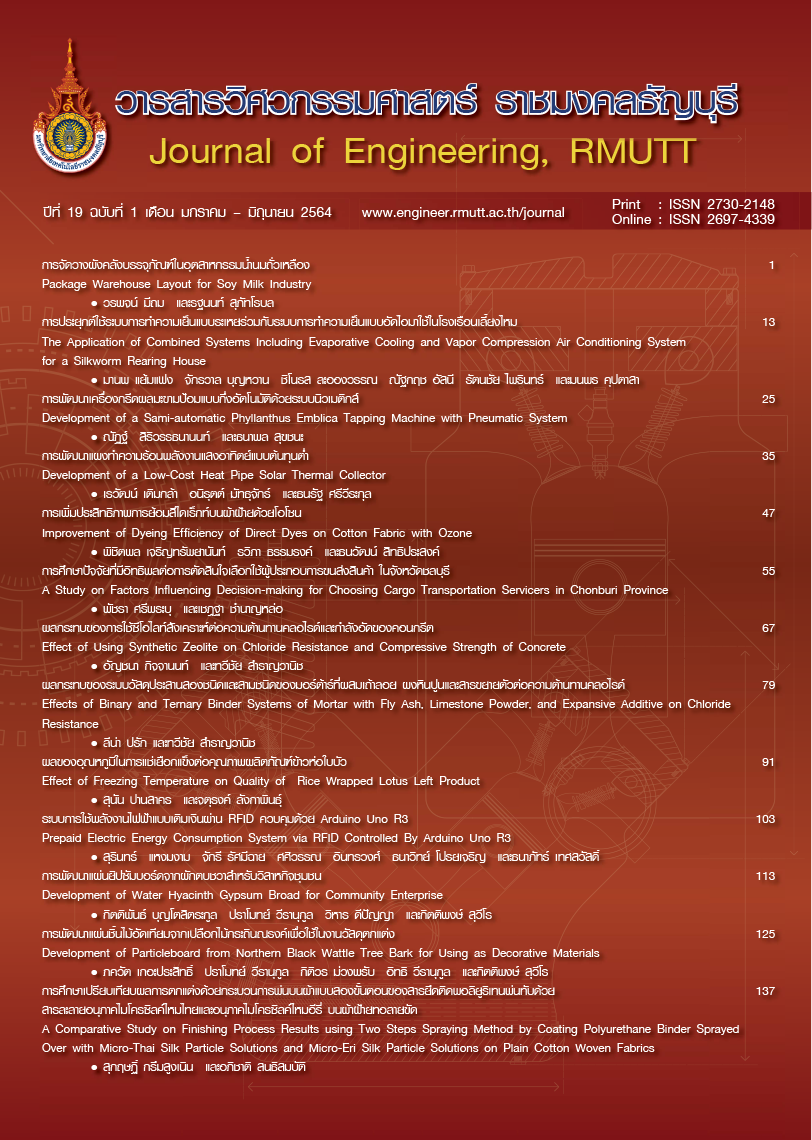การประยุกต์ใช้ระบบการทำความเย็นแบบระเหยร่วมกับระบบการทำความเย็นแบบอัดไอมาใช้ ในโรงเรือนเลี้ยงไหม
Main Article Content
บทคัดย่อ
งานวิจัยนี้เป็นการศึกษาการเปลี่ยนแปลงของอุณหภูมิและความชื้นในโรงเรือนเลี้ยงไหม โดยการใช้ระบบการทำความเย็นแบบระเหยร่วมกับระบบการทำความเย็นแบบอัดไอ โดยทำการทดลองในโรงเรือนที่มีขนาดกว้าง 10 เมตร ยาว 21 เมตร สูง 3 เมตร สำหรับระบบการทำความเย็นแบบระเหยจะทำการติดตั้งแผ่นระเหยน้ำขนาดกว้าง 1.5 เมตร สูง 1.8 เมตร หนา 0.15 เมตร จำนวน 6 ชุด บนผนังด้านทิศใต้ของโรงเรือน และมีพัดลมดูดอากาศขนาด 30 นิ้ว จำนวน 6 ตัว ติดตั้งที่ผนังด้านทิศเหนือของโรงเรือน ส่วนระบบการทำความเย็นแบบอัดไอนั้นจะใช้เครื่องปรับอากาศขนาด 30,000 Btu/hr จำนวน 4 เครื่อง ผลการทดลองจากโรงเรือนที่ใช้ระบบการทำความเย็นแบบระเหยสำหรับเลี้ยงไหมวัย 1 วัย 2 และวัย 3 พบว่ามีค่าความแตกต่างเฉลี่ยจากอุณหภูมิเหมาะสมสำหรับเลี้ยงไหมวัยดังกล่าวคือ 0.4oC 1.0oC และ1.9oC ตามลำดับ สำหรับความชื้นสัมพัทธ์ของอากาศในโรงเรือน มีค่าความแตกต่างเฉลี่ย 6.09% 0.61% และ 3.29% ตามลำดับ ส่วนระบบการทำความเย็นแบบอัดไอที่ใช้เลี้ยงไหมวัย 4 และวัย 5 นั้นพบว่าค่าความแตกต่างเฉลี่ยของอุณหภูมิและความชื้นสัมพัทธ์ของอากาศเหมาะสม สำหรับการเลี้ยงไหมวัย 4 คือ 2.2oC 0.33% และ 3.1oC 4.86% สำหรับไหมวัย 5
Article Details
บทความ ข้อมูล เนื้อหา รูปภาพ ฯลฯ ที่ได้รับการตีพิมพ์ในวารสารแนวหน้าวิจัยนวัตกรรมทางวิศวกรรม ถือเป็นลิขสิทธิ์ของวารสารฯ เท่านั้น ไม่อนุญาติให้บุคคลหรือหน่วยงานใดคัดลอกเนื้อหาทั้งหมดหรือส่วนหนึ่งส่วนใดไปเผยแพร่เพื่อกระทำการใด ๆ ที่ไม่ถูกต้องตามหลักจริยธรรม
References
Chuprayoon S. Silk production techniques. Department of Agricultural Extension. 80 p.
John A, Zahra Giabaklou. A passive evaporative cooling system by natural ventilation. Building and Environment. 1996;31(6):503-7.
Dai Y.J, Sumathy K. Theoretical study on a cross–flow direct evaporative cooler using honeycomb paper as packing material. Applied Thermal Engineering. 2002;(22): 1417-30.
Maheshwari G.P, Al-Ragom F, Suri R.K. Energy-saving potential of an indirect evaporative cooler. Applied Energy. 2001;(69):69-76.
Faleh Al-Sulaiman. Evaluation of the performance of local fibers in evaporative cooling. Energy Conversion and Management. 2002;(43):2267-73.
Hisham T.A, El-Dessouky, Amir A.Al-Haddad, Faisal Al-Juwayhel. Thermal and hydraulic performance of a modifide two-stage evaporative cooler. Renewable Energy. 1996;7(2):165-76.
Jain J.K, Hindoliya D.A. Experimental performance of new evaporative cooling pad materials. Sustainable Cities and Society. 2011;(1): 252-6.
Pervin A.D, Saffa R, Guohui G, Devrim A. Experimental study of the potential of eucalyptus fibres for evaporative cooling. Renewable Energy. 2019;(131):250-60.
Xu J, Li Y, Wang R.Z, Liu W, Zhou P. Experimental performance of evaporative cooling pad systems in greenhouses in humid subtropical climates. Applied Energy. 2015; (138):291-301.
Singh A, Kumar S, Dev R. Studies on cocopeat, sawdust and dried cow dung as desiccant for evaporative cooling system. Renewable Energy. 2019;(142):295-303.

